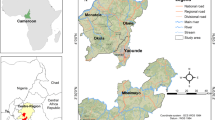Abstract
The diffusion of radon in dwellings is a process determined by the radon concentration gradient across the building material structure between the radon source and the surrounding air, and can be a significant contributor to indoor radon inflow. Radon can originate from the deeply buried deposit beneath homes and can migrate to the surface of earth. Radon emanates to the surfaces mainly by diffusion processes from the point of origin following α-decay of 226Ra in underground soil and building materials used, in the construction of floors, walls, and ceilings. In the present study radon diffusion through some building materials viz. coarse sand and stone dust of different grain size has been carried out using LR-115 type II solid-state nuclear track detectors (SSNTDs). The radon diffusion coefficients and diffusion lengths through these building construction materials have been calculated. The effect of grain size on radon diffusion through these building materials shows the decrease in radon diffusion with decrease in grain size.
Similar content being viewed by others
References
L A Cole Elements of Risk: The Politics of Radon. (Washington, DC: AAAS Press) (1993)
R N Proctor Cancer Wars (New York: Basic Books) (1995)
BEIR VI (Report on the Biological effects of Ionizing Radiation) Natl Res. Council. (Washington, DC: Natl. Acad. Press) (1999)
K J Renken and T Rosenberg Health Phys. 68 800 (1995)
R S Lively and K J Goldberg Radial Protect. Dosim. 82 31 (1999)
A B Tanner in The Natural Radiation Environment III. (eds) T F Gendsell and W M Lowder (University of Chicago Press) p5 (1980)
S Singh, J Kumar, B Singh and J Singh Radiation Measurements 30 461 (1999)
R P Chauhan and S K Chakarvarti Radiation Measurements 35 146 (2002)
K P Eappen, T V Ramachandran, A N Saikh and Y S Mayya Rad. Prot. Env. 24 410 (2001)
R P Chauhan, K Kant, G S Sharma, K Mahesh and S K Chakarvarti Rad. Prot. Env. 24 371 (2001)
G Keller Rad. Prot. Dos. 45 565 (1992)
M Tuffail, S M Mirza, M K Chugtai, N Ahamad and H A Khan Nucl. Track. Rad. Meas. 19 427 (1991)
Author information
Authors and Affiliations
Corresponding author
Rights and permissions
About this article
Cite this article
Narula, A.K., Goyal, S.K., Saini, S. et al. Calculation of radon diffusion coefficient and diffusion length for different building construction materials. Indian J Phys 83, 1171–1175 (2009). https://doi.org/10.1007/s12648-009-0097-9
Published:
Issue Date:
DOI: https://doi.org/10.1007/s12648-009-0097-9




